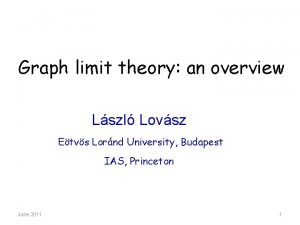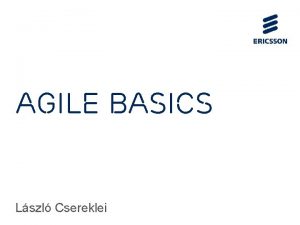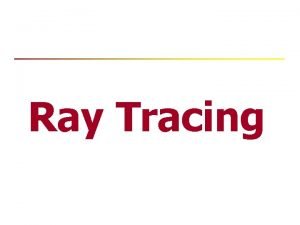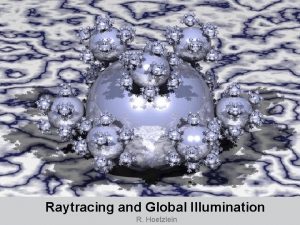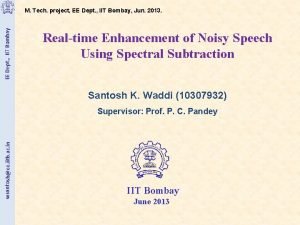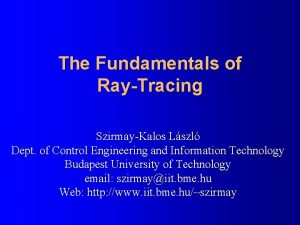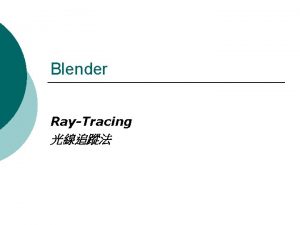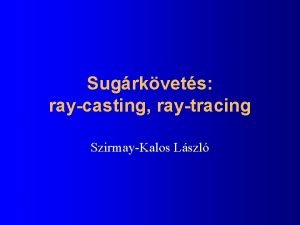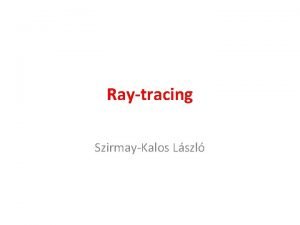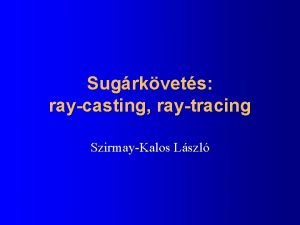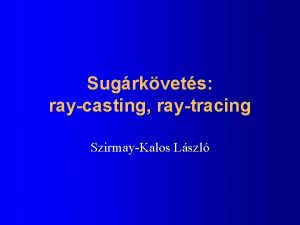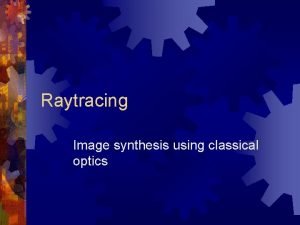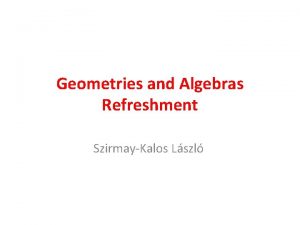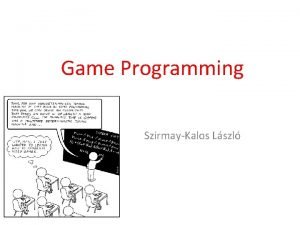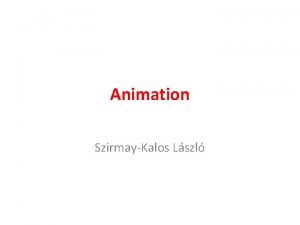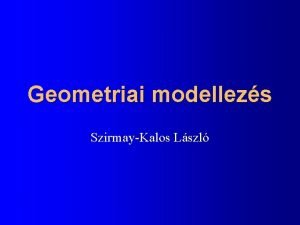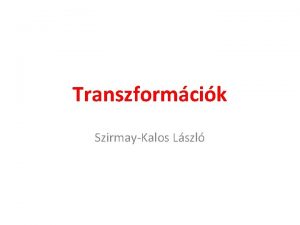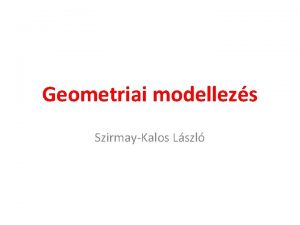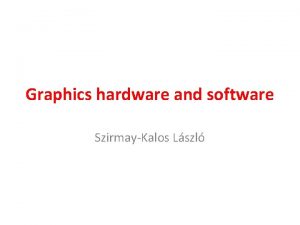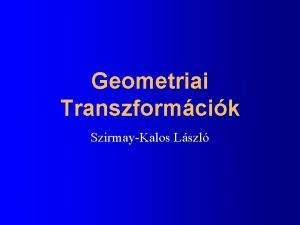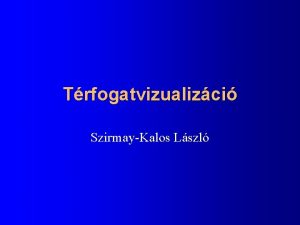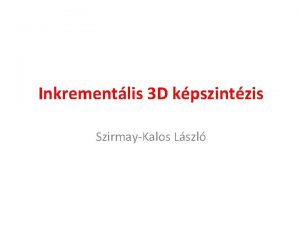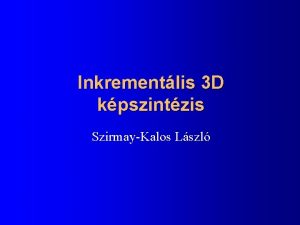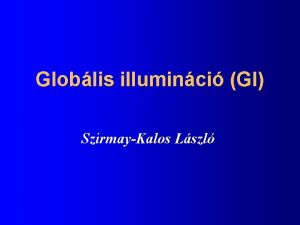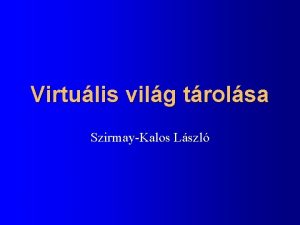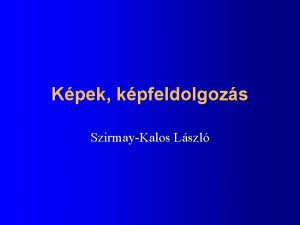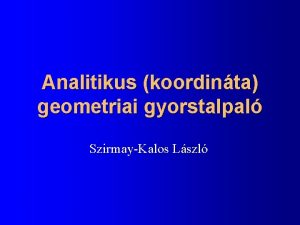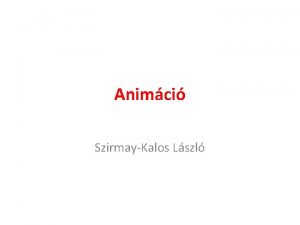The Fundamentals of RayTracing SzirmayKalos Lszl Dept of






















![Intersecting parametric sufaces r(u, v), u, v in [0, 1] ray(t) = eye + Intersecting parametric sufaces r(u, v), u, v in [0, 1] ray(t) = eye +](https://slidetodoc.com/presentation_image/fe76cf6f2a5a71f99ca7e9291c0f7d2c/image-23.jpg)


















- Slides: 41

The Fundamentals of Ray-Tracing Szirmay-Kalos László Dept. of Control Engineering and Information Technology Budapest University of Technology email: szirmay@iit. bme. hu Web: http: //www. iit. bme. hu/~szirmay

Rendering Tone mapping pixel Virtual world color Real world

Light-object interaction kr Lin Lin ’ ’ Lin fr( ’, ) cos ’ kt Lin Coherent terms geometric optics prob. density Incoherent terms probability theory BRDF: fr( ’, ) = Lout/Lin cos ’ Bi-directional reflection distribution function

BRDF modelling l Depends on – the wavelength – light direction – viewing direction – surface normal Physical measurements l Tuning simple formulae l

Diffuse reflection l Light intensity is independent of the viewing direction ’ ’ Lref = Lir kd ( ) cos ’ Lambert’s law

Diffuse surfaces

Phong’s specular reflection ’r ’r ’ = diffuse + Function: large at y=0 and goes to zero ks cosn y y ’

Diffuse+Phong materials own color diffuse Plastics: Phong ks is white diffuse + Phong n= 5 10 20 50

Diffuse + Phong materials

General rendering problem L r Le t

Local Illumination Light sources pixel ’l L ( ) Le( )+Sl rl Ll ( ’l) fr ( ’l , ) cos ’l 0/1: Light source visibility Shadows Point, directional light sources

Role of the ambient term Local illumination + ambient term L ( ) Le( )+Sl rl Ll ( ’l) fr ( ’l , ) cos ’l + ka La

Ray-tracing Refracted ray Reflection ray shadow ray Ll L( ) = Le( )+Sl rl Ll ( ’l) fr ( ’l , ) cos ’l + ka La + + kr Lin ( r) + kt Lin( t) from the reflection direction from the refraction direction

Local illumination + shadows Ray-tracing Global illumination Photorealistic image synthesis

Refracted ray Steps of ray-tracing Reflection ray shadow ray l Light intensity coming through a pixel – Visible point and the normal vector here – Visible light sources from here – mirror and refraction directions – Light intensity coming from the reflection direction – Light intensity coming form the refraction direction – Adding up the light components and Recursion color the pixel

Tasks of ray-tracing l Visibility computation – Determination of that point which is visible from a point in a given direction + normal vector here – point+direction = ray l l Computation of the mirroring and refraction directions Evaluation of the illumination formula L( ) = Le( )+Sl rl Ll ( ’l) fr ( ’l , ) cos ’l + ka La + + kr Lin ( r) + kt Lin( t)

Visibility calculation x ray(t) = eye + v ·t, t > 0 float First. Intersect(ray iobject, x) // <=0 if no intersection t = -1 FOR each object tnew = Intersect( ray, object ); // <= 0 if no intersection IF (tnew > 0 && tnew < t) t = tnew, iobject = object ENDFOR IF (t > 0) x = eye + v ·t; RETURN t; END

Intersection with a Sphere |r - center |2 = R 2 r R center no root 1 root 2 roots |ray(t) - center |2 = R 2 (v ·v) t 2 + 2 ((eye-center) ·v) t +((eye-center) ·(eye-center))- R 2 = 0 Wanted: minimum from the positive solutions Surface normal: (ray(t) - center)/R

Quadric surfaces Quadric surface: Ellipsoid 2 2 z 2 x y + + -1=0 a 2 b 2 c 2 x [x, y, z, 1] A y = 0 z 1 Infinite cone x 2 y 2 2 2 + - z =0 2 a b Second order equation Infinite cylinder x 2 y 2 + 2 - 1 =0 2 a b

Triangle Phase 1 Phase 2 r 3 n p r 1 1. Intersection with the plane: (ray(t) - r 1) ·n = 0, t > 0 Normal vector: n = (r 2 - r 1) x (r 3 - r 1) 2. Is the intersection point p inside the triangle? ((r 2 - r 1) x (p - r 1)) · ((r 2 - r 1) x (r 3 - r 1)) > 0 ((r 3 - r 2) x (p - r 2)) · ((r 3 - r 2) x (r 1 - r 2)) > 0 ((r 1 - r 3) x (p - r 3)) · ((r 1 - r 3) x (r 2 - r 3)) > 0 r 2

Shading normals N 2 N N 3 N 1 (X 1 , Y 1 , Z 1 ) N = A X + B Y+C N 1 = A X 1 + B Y 1 + C N 2 = A X 2 + B Y 2 + C N 3 = A X 3 + B Y 3 + C A, B, C 3 systems of equations of 3 unknowns

Parametric surfaces control points r(u, v) = S S Bi, j (u, v) ri, j blending functions
![Intersecting parametric sufaces ru v u v in 0 1 rayt eye Intersecting parametric sufaces r(u, v), u, v in [0, 1] ray(t) = eye +](https://slidetodoc.com/presentation_image/fe76cf6f2a5a71f99ca7e9291c0f7d2c/image-23.jpg)
Intersecting parametric sufaces r(u, v), u, v in [0, 1] ray(t) = eye + v ·t, t > 0 r(u, v) = ray(t) Solution of the equation: u, v, t Test: 0< u, v < 1, t>0 r(0, 0) r(0, 0. 5) r(0. 5, 0) r(1, 0) r(0, 1) r(0. 5, 0. 5) r(1, 1) Recursive tessellation

Animated objects T 1 -1 T 2 -1

Tasks of ray-tracing l Visibility computation – Determination of that point which is visible from a point in a given direction + normal vector here – point+direction = ray l l Computation of the mirroring and refraction directions Evaluation of the illumination formula

Reflection Direction horizontal vector N new ray = x + vr ·t v + N cosa v r a a x cos a = - (v·N) vr = v + 2 cos a N L = vr, V= v Reflect. Dir( L, N, V ) { L = V - N * (N * V) * 2; }

Refraction Direction horizontal vector v + Ncosa v a N sin a n = sin b N sinb b vt -Ncosb N Snellius law v+Ncosa N = sina vt = N sinb - Ncosb vt = v/n + N(cosa/n- cosb) cosb = 1 - sin 2 b = 1 - sin 2 a/n 2 vt = v/n + N (cosa/n - (1 - cos 2 a)/n 2) )

Camera definition fov, aspect lookat eye XRES, YRES

Ray-tracing algorithm ray p Render( ) for each pixel p Ray r = ray( eye pixel p ) color = Trace(ray) Write. Pixel(p, color) endfor end p color

Trace function Color Trace( ray, ray )d) Color IF d > dmax THEN RETURN La IF ((First. Intersect(ray IF First. Intersect(ray object, x) x) <= <= 0) 0) RETURN L Laa RETURN ENDIF color == L Lee (x, -ray. dir) color += += Direct Lightsource(x, -ray. dir) color IF (( kkrr >> 00 )) THEN IF Reflect. Dir( ray, reflected ray) Reflect. Dir( color += += kkrr ··Trace(reflectedray, ray d+1 ) color ) ENDIF IF (( kktt >> 00 && && Refract. Dir( ray, refracted ray )) )) IF color += += kktt ··Trace(refractedray, ray d+1 ) color ) ENDIF RETURN color RETURN ray x

Direct. Lightsource function Direct. Lightsource( x, vdir ) color = ka La shadow FOR each lightsource l DO shadowray = x to lightsource[l] t = First. Intersect( shadowray ); IF (t < 0 || t > |x - lightsource[l]. pos|) color += Brdf(ldir, x, vdir) cos l' lightsource[l]. Intensity ENDIF ENDFOR RETURN color pixel vdir x

Material Le, kd, ks, shine kr, kt, n BRDF Reflect. Dir Refract. Dir Ray-tracer class diagram Object transform Primitive( ) Primitive Scene La Define Render First. Intersect Direct. Lightsource Trace(Ray) Light Le, pos Dir(Point) Intens(Point) Intersect(Ray) Normal( ) Camera Sphere Center, radius Intersect(Ray) Normal( ) Mesh vertices[ ] Intersect(Ray) Normal( ) XRES, YRES eye, lookat, vup fov, aspect Ray Get. XRes( ) Get. YRes( ) Get. Ray(int, int) Dir( ) Start( ) dir, start

Ray-tracing: results Pov. Ray Computation time Pixel# · Object# ·(Light source# + 1)

Speeding up the intersection calculation Speeding up for each objects: – bounding volumes l Computing for less number of objects: – space partitioning l

Bounding Volume float Intersect. BV( ray, object ) // < 0 ha nincs IF ( Intersect( ray, bounding volume of object) <=0) RETURN -1; RETURN Intersect( ray, object ); END

Space partitioning methods objects preprocessing Space-partitioning data structure raytracing First intersection Data structure: • Knowing the ray, it reduces the number of objects the ray may intersect. • If we find an intersected object, the search can be terminated.

Uniform space partitioning Preprocessing: FOR each cell identify the objects that are partly here complexity: O(n ·c ) = O(n 2) Ray-tracing: FOR each cell of the line // line drawing Intersect objects registered in this cell IF intersection exists RETURN ENDFOR average case complexity: O(1 )

Tree build IF a cell contains just a few objects register objects in this cell ELSE subdivide cells: c 1, c 2, …, c 8 Tree build(c 1); … Tree build(c 8); ENDIF Octree 2 1 3 Ray-shooting: FOR each cell intersecting the line Intersect objects registered in this cell IF intersection exists RETURN ENDFOR 1 2 Octree 3 3

Tree build: IF a cell contains just a few objects register objects in this cell ELSE find a subdivision plane cell halving with the plane: c 1, c 2 Tree build (c 1); Tree build (c 2); ENDIF Kd (BSP) tree 2 1 Ray-shooting: FOR each cell intersecting the line Intersect with the included objects IF intersection exists RETURN ENDFOR 3 1 kd-tree 2 3

Example 1

Example 2
 Graph limit theory
Graph limit theory Lszl charts
Lszl charts How does raytracing work
How does raytracing work Rasterization vs ray tracing
Rasterization vs ray tracing Bromocicloesano
Bromocicloesano Liz welch mississippi
Liz welch mississippi La dept of revenue
La dept of revenue Dept of education
Dept of education Gome dept
Gome dept Vaginal dept
Vaginal dept Iit
Iit Inspectors in worcester
Inspectors in worcester Central islip fire department
Central islip fire department Hoe dept
Hoe dept Dept. name of organization (of affiliation)
Dept. name of organization (of affiliation) La geaux biz
La geaux biz Florida dept of agriculture and consumer services
Florida dept of agriculture and consumer services Dept nmr spectroscopy
Dept nmr spectroscopy Gome dept
Gome dept Dept ind onegov
Dept ind onegov Dept. name of organization
Dept. name of organization Pt dept logistik
Pt dept logistik Rowan county dept of social services
Rowan county dept of social services Fire dept interview questions
Fire dept interview questions Employment first ohio
Employment first ohio Rewley house continuing education library
Rewley house continuing education library Florida dept of agriculture and consumer services
Florida dept of agriculture and consumer services Florida dept of agriculture and consumer services
Florida dept of agriculture and consumer services Nyttofunktion
Nyttofunktion Albany county dss
Albany county dss Dept of education
Dept of education Mn dept of education
Mn dept of education Nys dept of homeland security
Nys dept of homeland security Maine dept of agriculture
Maine dept of agriculture Nebraska dept of agriculture
Nebraska dept of agriculture Affiliation poster
Affiliation poster Dept a
Dept a Finance departments
Finance departments Gome dept
Gome dept Các loại đột biến cấu trúc nhiễm sắc thể
Các loại đột biến cấu trúc nhiễm sắc thể Vẽ hình chiếu đứng bằng cạnh của vật thể
Vẽ hình chiếu đứng bằng cạnh của vật thể độ dài liên kết
độ dài liên kết
